
In astrogeology, chaos terrain, or chaotic terrain, is a planetary surface area where features such as ridges, cracks, and plains appear jumbled and enmeshed with one another. Chaos terrain is a notable feature of the planets Mars and Mercury, Jupiter's moon Europa, and the dwarf planet Pluto. In scientific nomenclature, "chaos" is used as a component of proper nouns (e.g., "Aureum Chaos" on Mars).[1]
On Mars
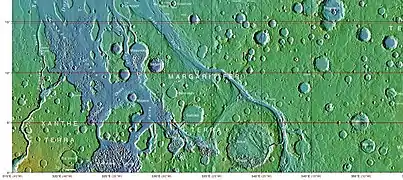 Topography map of Oxia Palus region of Mars, showing the location of a number of chaos regions
Topography map of Oxia Palus region of Mars, showing the location of a number of chaos regions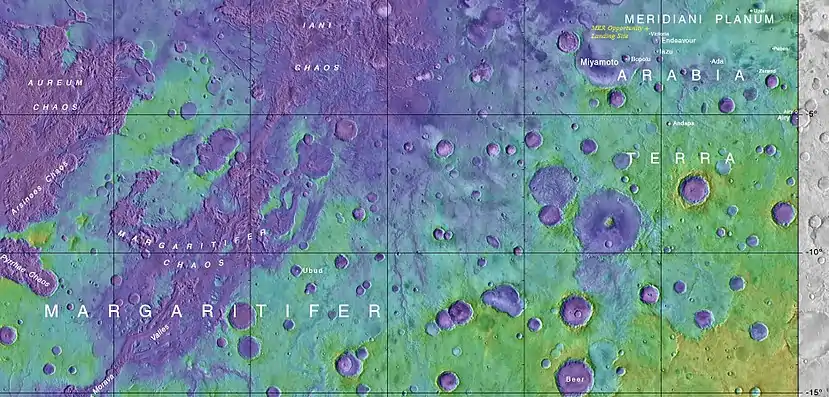 Map showing location of Arsinoes Chaos (far left), Iani Chaos, Aureum Chaos, Margaritifer Chaos, and other nearby features
Map showing location of Arsinoes Chaos (far left), Iani Chaos, Aureum Chaos, Margaritifer Chaos, and other nearby features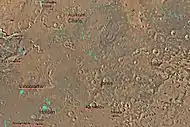 Map of Margaritifer Sinus quadrangle with major features labeled. Aureum Chaos is near the top of the map.
Map of Margaritifer Sinus quadrangle with major features labeled. Aureum Chaos is near the top of the map.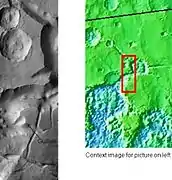 Huge canyons in Aureum Chaos, as seen by THEMIS. Gullies are rare at this latitude. Image from Margaritifer Sinus quadrangle.
Huge canyons in Aureum Chaos, as seen by THEMIS. Gullies are rare at this latitude. Image from Margaritifer Sinus quadrangle.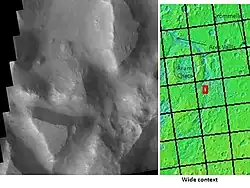 Iani Chaos, as seen by THEMIS. Sand from eroding mesas is covering brighter floor material. Click on image to see relationship of Iani Chaos to other local features. Image from Margaritifer Sinus quadrangle.
Iani Chaos, as seen by THEMIS. Sand from eroding mesas is covering brighter floor material. Click on image to see relationship of Iani Chaos to other local features. Image from Margaritifer Sinus quadrangle. Quadrangle map of Oxia Palus quadrangle labeled with major features. This quadrangle contains many collapsed areas of Chaos and many outflow channels (old river valleys).
Quadrangle map of Oxia Palus quadrangle labeled with major features. This quadrangle contains many collapsed areas of Chaos and many outflow channels (old river valleys).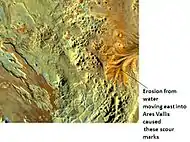 Erosion in Aram Chaos, as seen by THEMIS. Image in Oxia Palus quadrangle.
Erosion in Aram Chaos, as seen by THEMIS. Image in Oxia Palus quadrangle. Blocks in Aram showing possible source of water, as seen by THEMIS. Image in Oxia Palus quadrangle.
Blocks in Aram showing possible source of water, as seen by THEMIS. Image in Oxia Palus quadrangle.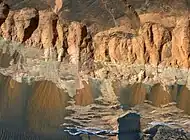 Badlands of Aram Chaos
Badlands of Aram Chaos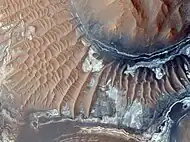 Eastern floor of Aram Chaos
Eastern floor of Aram Chaos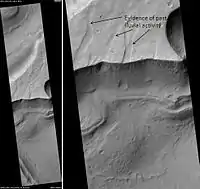 Hydraotes Chaos, as seen by HiRISE. Click on image to see channels and layers. Scale bar is 1,000 m (3,300 ft) long. Image in Oxia Palus quadrangle.
Hydraotes Chaos, as seen by HiRISE. Click on image to see channels and layers. Scale bar is 1,000 m (3,300 ft) long. Image in Oxia Palus quadrangle.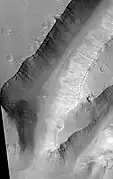 Hydaspis Chaos, as seen by HiRISE. Image in Oxia Palus quadrangle.
Hydaspis Chaos, as seen by HiRISE. Image in Oxia Palus quadrangle.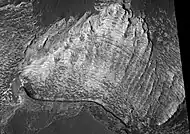
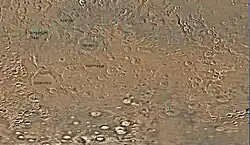 Map of Phaethontis quadrangle. Click to enlarge and see some crater names. Gorgonum Chaos is near the top of the map.
Map of Phaethontis quadrangle. Click to enlarge and see some crater names. Gorgonum Chaos is near the top of the map.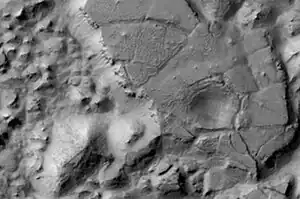 Gorgonum Chaos as seen by Mars Reconnaissance Orbiter HiRISE. Image is 4 km (2.5 mi) wide. Image in Phaethontis quadrangle.
Gorgonum Chaos as seen by Mars Reconnaissance Orbiter HiRISE. Image is 4 km (2.5 mi) wide. Image in Phaethontis quadrangle.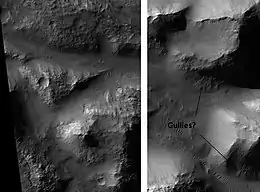 Atlantis Chaos, as seen by HiRISE. Click on image to see mantle covering and possible gullies. The two images are different parts of the original image. They have different scales. Image in Phaethontis quadrangle.
Atlantis Chaos, as seen by HiRISE. Click on image to see mantle covering and possible gullies. The two images are different parts of the original image. They have different scales. Image in Phaethontis quadrangle.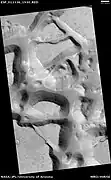 Ister Chaos, as seen by HiRISE. Location is the Lunae Palus quadrangle.
Ister Chaos, as seen by HiRISE. Location is the Lunae Palus quadrangle. Close-up of Ister Chaos, as seen by HiRISE. Location is the Lunae Palus quadrangle.
Close-up of Ister Chaos, as seen by HiRISE. Location is the Lunae Palus quadrangle. Chaos terrain, as seen by HiRISE under HiWish program. Location is Margaritifer Sinus quadrangle
Chaos terrain, as seen by HiRISE under HiWish program. Location is Margaritifer Sinus quadrangle
On April 1, 2010, NASA released the first images under the HiWish program in which citizens suggested places for HiRISE to photograph. One of the eight locations was Aureum Chaos.[2] The first image below gives a wide view of the area. The next two images are from the HiRISE image.[3]
 THEMIS image of wide view of following HiRISE images. Black box shows approximate location of HiRISE images. This image is just a part of the vast area known as Aureum Chaos. Click on image to see more details.
THEMIS image of wide view of following HiRISE images. Black box shows approximate location of HiRISE images. This image is just a part of the vast area known as Aureum Chaos. Click on image to see more details.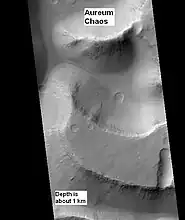 Aureum Chaos, as seen by HiRISE, under the HiWish program.
Aureum Chaos, as seen by HiRISE, under the HiWish program.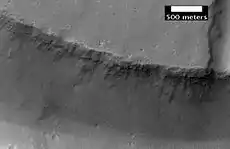 Close up view of previous image, as seen by HiRISE under HiWish program. Small round dots are boulders.
Close up view of previous image, as seen by HiRISE under HiWish program. Small round dots are boulders.
On Mercury
On Mercury, chaos terrain can be hilly or lineated. An original theory for the formation of chaos terrain on Mercury is an impact basin on the opposite side of the planet. However, there is some terrain on Mercury that has no connections to an impact basin, so this theory doesn’t fully explain Mercury’s chaos terrain.[4]
A large portion of chaos terrain on Mercury is antipodal to the Caloris basin. They are the result of the ejecta and resurfacing caused by such a large impact.[4]
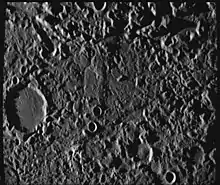 The chaotic terrain at the antipode of the Caloris Basin
The chaotic terrain at the antipode of the Caloris Basin
On Europa
Chaos terrain is plentiful on Europa, covering between 20 and 40% of the surface. While many theories have been proposed, none yet fully explains the origin of this terrain.[5] On Europa, “chaos terrain” includes geological features such as chaos lenticulae, pits, spots, and domes. Chaos terrain has been observed at both a higher and lower altitude than surrounding non-chaos terrain but is most often uplifted from nearby topography.
Nearly all observed chaos terrain lies on top of its surroundings, indicating chaos terrain is a relatively young feature on Europa. Chaos terrain can fall into two categories on Europa: “fresh” and “modified”.[5] Fresh chaos terrain is very young and has not been crosscut by other geological features. Modified chaos terrain is older, with smoother edges and crosscutting features.
A possible origin of the lenticulae on Europa’s surface is the strong gravitational pull of Jupiter.[6] As the surface is stretched and squished, the surface may crack and pull apart, or be pushed together. Another potential origin of various chaos terrain on Europa is interactions between the icy surface and liquid ocean under Europa’s surface. Warm water plumes can melt the surface of Europa, and then movements of the shell can move chaos terrain to a different location than where it was formed.
On Pluto
Chaos terrain on Pluto is not as well understood as that on other bodies. On Pluto, chaos terrain is referred to most often as “Montes” and are likely made up mostly of water ice, which at the temperature of Pluto’s surface acts as bedrock. Additionally, at Pluto’s temperature, nitrogen ice is not able to form the tall topographical features we observe around the Sputnik basin, further proving water ice as the main component of the montes formations. Most of the montes on Pluto are on the outside edges of Sputnik Planitia, a giant impact basin. The cause of this is the uplift and disruption due to the high-energy impact.[7]
Causes
The specific causes of chaos terrain are not yet well understood. A number of different astrogeological forces have been offered as causes of chaos terrain. On Europa, impact events and subsequent penetration into a ductile or liquid crust were suggested in 2004.[8] In November 2011, a team of researchers from the University of Texas at Austin and elsewhere presented evidence in the journal Nature suggesting that many "chaos terrain" features on Europa sit atop vast lakes of liquid water.[9] These lakes would be entirely encased in the moon's icy outer shell and distinct from a liquid ocean thought to exist farther down beneath the ice shell. Rather than an external impact, the authors propose a four-step model for producing the surface expressions (chaos terrain) and the shallow, covered lakes. Full confirmation of the lakes' existence will require a space mission designed to probe the ice shell either physically or indirectly, for example using radar.
On Mars, chaos terrain is believed to be associated with the release of huge amounts of water. The chaotic features may have collapsed when water came out of the surface. Martian rivers begin with a chaos region. A chaotic region can be recognized by a rat's nest of mesas, buttes, and hills, chopped through with valleys which in places look almost patterned. Some parts of this chaotic area have not collapsed completely—they are still formed into large mesas, so they may still contain water ice.[10] Chaotic terrain occurs in numerous locations on Mars, and always gives the strong impression that something abruptly disturbed the ground. Chaos regions formed long ago. By counting craters (more craters in any given area means an older surface) and by studying the valleys' relations with other geological features, scientists have concluded the channels formed 2.0 to 3.8 billion years ago.[11]
Scientists have thought of different ideas for the cause of chaotic terrain. One explanation for the source of the water that quickly left the ground and created chaos is that water rich sediment was deposited in giant canyons on the floor of an ocean. Later, when the ocean disappeared, the sediments froze. If hot magma came near to the region, the ice would have melted and formed large underground river systems. When these neared the surface, huge amounts would break out of the ground and carve the valleys we see today. There is much evidence for an ocean on Mars.[12][13][14][15] Places have been photographed that could be where the ground collapsed when water left subterranean rivers to flow out of chaotic regions.[16][17] One of the first theories for the source of the water was based on old Viking Orbiter pictures. It was thought that these outflows came from a global cryosphere-confined aquifer that collected water from south polar meltwater.[18][19] The cryosphere would have formed during the Hesperian period in the planet's history into the planet's upper crust.[17] One chaotic terrain, Galaxias Chaos may be caused by sublimation of an ice-rich deposit.[20]
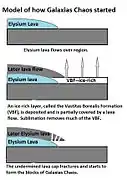 This series of drawings show another model for the formation of Martian chaos, as proposed by Pedersen and Head, 2011. Amount of sublimation is exaggerated to improve understanding. Click on image to see more details.
This series of drawings show another model for the formation of Martian chaos, as proposed by Pedersen and Head, 2011. Amount of sublimation is exaggerated to improve understanding. Click on image to see more details.
In popular culture
- In the graphic novel Watchmen, Dr. Manhattan ponders upon the alternative viewpoints of existence, and says that Mars did not choose life, but rather "chaotic terrain".
- In the science fiction novel Armada, Chaos Terrain is a business that makes videogames secretly designed to teach civilians how to fight Europan aliens.
See also
- Arachnoids – Large structure of unknown origin on Venus
- List of areas of chaos terrain on Mars
- Planetary geology – Geology of astronomical objects apparently in orbit around stellar objects
- Margaritifer Sinus quadrangle – One of a series of 30 quadrangle maps of Mars
- Geysers on Mars – Putative CO2 gas and dust eruptions on Mars
- Martian chaos terrain – Irregular groups of large blocks of rock
- Rille – Fissure, especially on the Moon
References
- ↑ Britt, Robert Roy (April 25, 2005). "Chaos on Mars". Space.com.
- ↑ "Captioned Images Inspired by HiWish Suggestions". HiRISE. Archived from the original on Dec 24, 2016.
- ↑ Okubo, Chris (March 2010). "Mesas in Aureum Chaos". HiRISE.
- 1 2 Rodriguez, J. Alexis P.; Leonard, Gregory J.; Kargel, Jeffrey S.; Domingue, Deborah; Berman, Daniel C.; Banks, Maria; Zarroca, Mario; Linares, Rogelio; Marchi, Simone; Baker, Victor R.; Webster, Kevin D.; Sykes, Mark (2020-03-16). "The Chaotic Terrains of Mercury Reveal a History of Planetary Volatile Retention and Loss in the Innermost Solar System". Scientific Reports. 10 (1): 4737. Bibcode:2020NatSR..10.4737R. doi:10.1038/s41598-020-59885-5. ISSN 2045-2322. PMC 7075900. PMID 32179758.
- 1 2 Collins, Geoffrey; Nimmo, Francis (2009). Europa. pp. 259–282.
- ↑ Schmidt, B. E.; Blankenship, D. D.; Patterson, G. W.; Schenk, P. M. (November 2011). "Active formation of 'chaos terrain' over shallow subsurface water on Europa". Nature. 479 (7374): 502–505. Bibcode:2011Natur.479..502S. doi:10.1038/nature10608. ISSN 1476-4687. PMID 22089135. S2CID 4405195.
- ↑ Skjetne, Helle L.; Singer, Kelsi N.; Hynek, Brian M.; Knight, Katie I.; Schenk, Paul M.; Olkin, Cathy B.; White, Oliver L.; Bertrand, Tanguy; Runyon, Kirby D.; McKinnon, William B.; Moore, Jeffrey M.; Stern, S. Alan; Weaver, Harold A.; Young, Leslie A.; Ennico, Kim (2021-03-01). "Morphological comparison of blocks in chaos terrains on Pluto, Europa, and Mars". Icarus. Pluto System, Kuiper Belt, and Kuiper Belt Objects. 356: 113866. arXiv:2104.12033. Bibcode:2021Icar..35613866S. doi:10.1016/j.icarus.2020.113866. ISSN 0019-1035. S2CID 219506634.
- ↑ Ong, Lissa (November 7, 2004). Evidence that chaos terrain on Jupiter's moon Europa is formed by crust-penetrating impacts. Geological Society of America Abstracts with Programs. Vol. 36. p. 144. Archived from the original on 2007-03-12.
- ↑ Schmidt, Britney; Blankenship, Don; Patterson, Wes; Schenk, Paul (November 24, 2011). "Active formation of 'chaos terrain' over shallow subsurface water on Europa". Nature. 479 (7374): 502–505. Bibcode:2011Natur.479..502S. doi:10.1038/nature10608. PMID 22089135. S2CID 4405195.
- ↑ "Unraveling the Chaos of Aram". Mars Odyssey THEMIS (THermal Emission Imaging System). Arizona State University.
- ↑ "Feature Image: Volcanism and Collapse in Hydraotes". Mars Odyssey THEMIS (THermal Emission Imaging System). Arizona State University. 2008-11-26. Retrieved 2021-04-22.
- ↑ Baker, V. R.; Strom, R. G.; Gulick, V. C.; Kargel, J. S.; Komatsu, G.; Kale, V. S. (1991). "Ancient oceans, ice sheets and the hydrological cycle on Mars". Nature. 352 (6336): 589–594. Bibcode:1991Natur.352..589B. doi:10.1038/352589a0. ISSN 0028-0836. S2CID 4321529.
- ↑ Head III, J. W. (10 December 1999). "Possible Ancient Oceans on Mars: Evidence from Mars Orbiter Laser Altimeter Data" (PDF). Science. 286 (5447): 2134–2137. Bibcode:1999Sci...286.2134H. doi:10.1126/science.286.5447.2134. ISSN 0036-8075. PMID 10591640 – via NASA Mars Exploration.
- ↑ Carr, Michael H. (2003). "Oceans on Mars: An assessment of the observational evidence and possible fate". Journal of Geophysical Research. 108 (E5): 5042. Bibcode:2003JGRE..108.5042C. doi:10.1029/2002JE001963. ISSN 0148-0227.
- ↑ Kreslavsky, Mikhail A.; Head, James W. (2002). "Fate of outflow channel effluents in the northern lowlands of Mars: The Vastitas Borealis Formation as a sublimation residue from frozen ponded bodies of water". Journal of Geophysical Research: Planets. 107 (E12): 4-1–4-25. Bibcode:2002JGRE..107.5121K. doi:10.1029/2001JE001831. ISSN 0148-0227.
- ↑ Cowing, Keith (September 11, 2015). "Regional, Not Global, Processes Led to Huge Martian Floods". SpaceRef. Archived from the original on September 29, 2015. Retrieved September 14, 2015.
- 1 2 Rodriguez, J. Alexis P.; Kargel, Jeffrey S.; Baker, Victor R.; et al. (2015). "Martian outflow channels: How did their source aquifers form, and why did they drain so rapidly?". Scientific Reports. 5: 13404. Bibcode:2015NatSR...513404R. doi:10.1038/srep13404. PMC 4562069. PMID 26346067.
- ↑ Clifford, Stephen M. (25 June 1993). "A model for the hydrologic and climatic behavior of water on Mars". Journal of Geophysical Research. 98 (E6): 10973–11016. Bibcode:1993JGR....9810973C. doi:10.1029/93JE00225. ISSN 0148-0227.
- ↑ Clifford, S (2001). "The Evolution of the Martian Hydrosphere: Implications for the Fate of a Primordial Ocean and the Current State of the Northern Plains" (PDF). Icarus. 154 (1): 40–79. Bibcode:2001Icar..154...40C. doi:10.1006/icar.2001.6671. ISSN 0019-1035 – via University of California, Berkeley Seismology Lab.
- ↑ Pedersen, G.B.M.; Head, J.W. (2011). "Chaos formation by sublimation of volatile-rich substrate: Evidence from Galaxias Chaos, Mars" (PDF). Icarus. 211 (1): 316–329. Bibcode:2011Icar..211..316P. doi:10.1016/j.icarus.2010.09.005. ISSN 0019-1035. Archived from the original (PDF) on Jan 29, 2013 – via Department of Earth, Environmental & Planetary Sciences | Brown University.